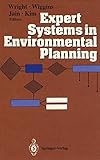Expert systems in environmental planning [Libro electrónico] / editores: Jeff R. Wright, Lyna L. Wiggins, Ravinder K. Jain, T. John Kim
Wright, Jeff R [editor] | Wiggins, Lyna L [editor/a] | Jain, Ravinder K [editor/a] | Kim, John [editor/a].
Tipo de material: Libro
en línea Editor: New York, New York, United States: Springer-Verlag, c1993Descripción: xxi, 311 páginas : ilustraciones ; 24 centímetros.ISBN: 3540560637; 0387560637; 9783642778728 (Print); 9783642778704 (Online).Tema(s): City planning -- Environmental aspects -- Data processing -- Congresses | Expert systems (Computer science) -- Congresses | Environmental protection -- Planning -- Data processing -- CongressesNota de acceso: Disponible para usuarios de ECOSUR con su clave de acceso Nota de bibliografía: Incluye bibliografía Número de sistema: 56191Contenidos:Mostrar
Resumen:
Libro
en línea Editor: New York, New York, United States: Springer-Verlag, c1993Descripción: xxi, 311 páginas : ilustraciones ; 24 centímetros.ISBN: 3540560637; 0387560637; 9783642778728 (Print); 9783642778704 (Online).Tema(s): City planning -- Environmental aspects -- Data processing -- Congresses | Expert systems (Computer science) -- Congresses | Environmental protection -- Planning -- Data processing -- CongressesNota de acceso: Disponible para usuarios de ECOSUR con su clave de acceso Nota de bibliografía: Incluye bibliografía Número de sistema: 56191Contenidos:Mostrar
Resumen:| Tipo de ítem | Biblioteca actual | Colección | Signatura | Estado | Fecha de vencimiento | Código de barras |
|---|---|---|---|---|---|---|
| Libros | Biblioteca Electrónica Recursos en línea (RE) | Acervo General | Recurso digital | ECO400561913350 |
Incluye bibliografía
Chapter 1. Land use and resource management.. Chapter 2. GIS and spatial modeling.. Chapter 3. Environmental planning and management.. Chapter 4. Knowledge acquisition, evaluation, and validation.. Bibliography
Disponible para usuarios de ECOSUR con su clave de acceso
The connections between economics, planning, and the environment are receiv ing increased attention among scholars and policy makers in many countries. The common denominator among these three variables is the earth's life support sys tems, the ecosystems on which the world depends. When we describe our physi cal surroundings as a collection of possible uses, we are establishing linkages between economics, planning, and the environment. Because possible alternative uses compete with each other, and conflicts arise over scarce land resources, the varying environmental impacts of alternative uses are major concerns for the cur rent as well as the next generation. How to achieve sustainable development is the pressing question for today's environmental professionals. Environmental planners and engineers help us study the implications of our choices, and new technologies and techniques that improve the practice of environmental planning should enhance our ability to protect our future. The depletion of the earth's natural resources and loss of biodiversity, the deg radation of air, land, and water quality, the accumulation of greenhouse gases leading to changes in our climate, and the depletion of the ozone layer comprise only a partial list of environmental issues that concern our policy makers. To sup port their decisions, environmental planning must be a multidimensional and multidisciplinary activity that incorporates social, economic, political, geograph ical, and technical factors. Solutions for problems in these areas frequently re quire not only numerical analyses but also heuristic analyses, which in turn depend on the intuitive judgements of planners and engineers. eng
Disponible en línea
Disponible en formato PDF
Subscripción a ELSEVIER 26 de diciembre del 2013
